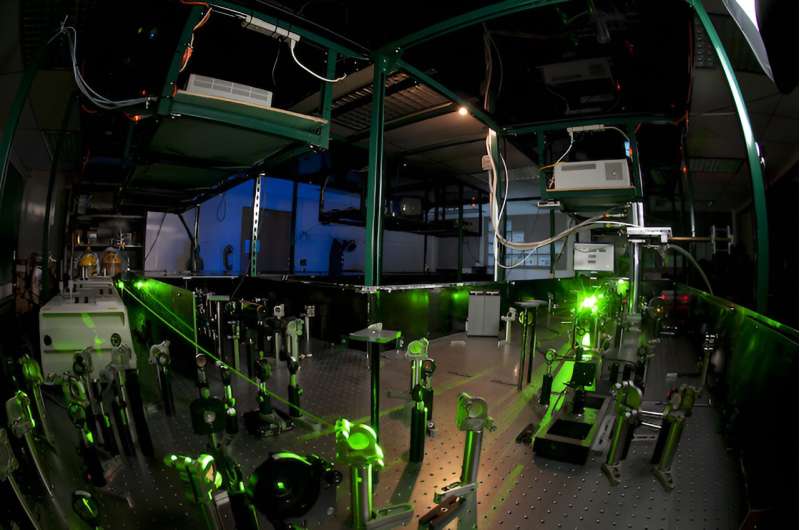Research at the University of Kansas’ Ultrafast Laser Laboratory could lead to breakthroughs in electronic control of semiconductors, a fundamental building block of most information and energy technologies.Image source: University of Kansas
Research appears in ACS Nano Instantly revealing the ballistic motion of electrons in graphene.
Observations from the University of Kansas’ Ultrafast Laser Laboratory could lead to breakthroughs in electronic control of semiconductors, the fundamental building blocks of most information and energy technologies.
“Typically, electron motion is interrupted by collisions with other particles in a solid,” said first author Ryan Scott, a doctoral student in the Department of Physics and Astronomy at the University of Kansas.
“It’s similar to someone running in a ballroom full of dancers. These collisions are quite frequent, about 10 to 100 billion times per second. They slow down the electrons, cause energy loss, and generate unnecessary heat. Without collisions, The electrons will move continuously “within a solid body, similar to a car on a highway or a ballistic missile in the air. We call this ‘ballistic transport’. “
Scott conducted laboratory experiments under the guidance of Hui Zhao, a professor of physics and astronomy at the University of Kansas. Their work was joined by former University of Kansas doctoral student Pavel Valencia-Acuna, now a postdoctoral researcher at Pacific Northwest National Laboratory.
Electronic devices transported using ballistics could be faster, more powerful and more energy-efficient, Zhao said.
“Current electronic devices, such as computers and phones, all use silicon-based field effect transistors,” Zhao said. “In such devices, electrons can only drift at speeds on the order of centimeters per second due to their frequent collisions. Ballistic transport of electrons in graphene can be used for fast, low-energy devices.”
Researchers at the University of Kansas observed the ballistic motion of graphene, a promising material for next-generation electronic devices. Graphene was first discovered in 2004 and won the Nobel Prize in Physics in 2010. Graphene is composed of a single layer of carbon atoms forming a hexagonal lattice structure similar to a football net.
“Electrons in graphene move as if their ‘effective’ mass was zero, which makes them more likely to avoid collisions and move ballistically,” Scott said. “Previous electrical experiments have looked at different The current generated by the voltage under the conditions revealed signs of ballistic transport. However, these techniques are not fast enough to track the movement of the electrons.”
Researchers say electrons in graphene (or any other semiconductor) are like students sitting in a full classroom, where students can’t move around freely because the desks are full. The laser can release electrons, temporarily freeing up the table, or what physicists call a “hole.”
“Light can provide energy to electrons to release them so they can move freely,” Zhao said. “This is similar to asking students to stand up and leave their seats. However, unlike students who have a neutral charge, electrons are negatively charged. Once an electron leaves its ‘seat,’ the seat becomes positively charged and quickly pulls the electron back, causing the electron to No more moving like a student sitting back in his seat.”
Because of this effect, ultralight electrons in graphene can only stay moving for about a trillionth of a second before falling back to their position. Such a short period of time poses a serious challenge to observing the movement of electrons. To solve this problem, researchers at the University of Kansas designed and fabricated a four-layer artificial structure in which two graphene layers are separated by two other single layers of materials: molybdenum disulfide and molybdenum diselenide.
“With this strategy, we were able to direct electrons to one graphene layer while retaining their ‘seat’ in another graphene layer,” Scott said. “Separating them with two layers of molecules with a total thickness of just 1.5 nanometers forces the electrons to stay moving for about 50 trillionths of a second, long enough for researchers equipped with devices as fast as 0.1 trillionths of a second. One second of laser light to study how they move.”
The researchers used a tightly focused laser spot to release some of the electrons in the sample. They tracked these electrons by plotting the samples’ “reflectivity,” or the percentage of light they reflected.
“We see most objects because they reflect light into our eyes,” Scott said.
“Brighter objects have greater reflectivity. Darker objects, on the other hand, absorb light, which is why dark clothes get hot in the summer. When mobile electrons move to a certain location in the sample, It makes that location slightly brighter by changing how the electrons at that location interact with light. Even if everything is optimized, the effect is very small, one electron will only change the reflectivity by 0.1 parts per million.”
To detect such small changes, the researchers released 20,000 electrons at a time, used a probe laser to bounce off the sample and measured the reflectivity, repeating the process 80 million times for each data point. They found that electrons travel ballistically at an average speed of 22 kilometers per second for about 20 trillionths of a second before encountering an object that terminates their ballistic motion.
More information:
Ryan J. Scott et al., Spatiotemporal observations of electron quasi-ballistic transport in graphene, ACS Nano (2023). DOI: 10.1021/acsnano.3c08816
Provided by University of Kansas
citation: Ultrafast laser maps “ballistic” electrons in graphene, with implications for next-generation electronic devices (2023, December 15), retrieved December 22, 2023, from https://phys.org/news /2023-12-ultrafast-lasers-electrons-ballistic-graphene.html
This document is protected by copyright. No part may be reproduced without written permission except in the interests of fair dealing for private study or research purposes. Content is for reference only.
#Ultrafast #laser #maps #electron #ballistics #graphene #impacting #nextgeneration #electronic #devices
Image Source : phys.org
